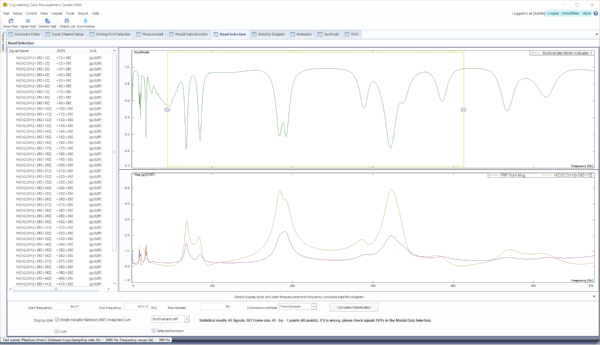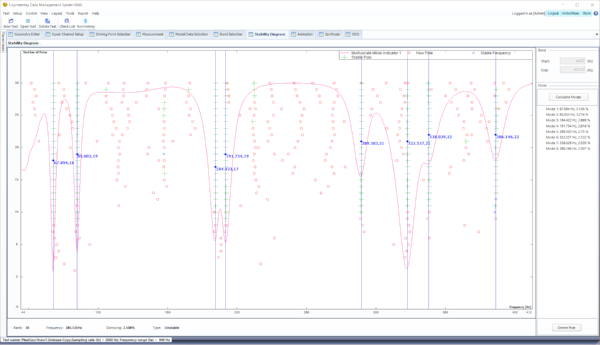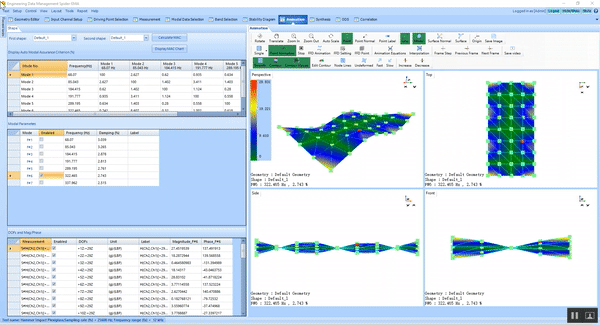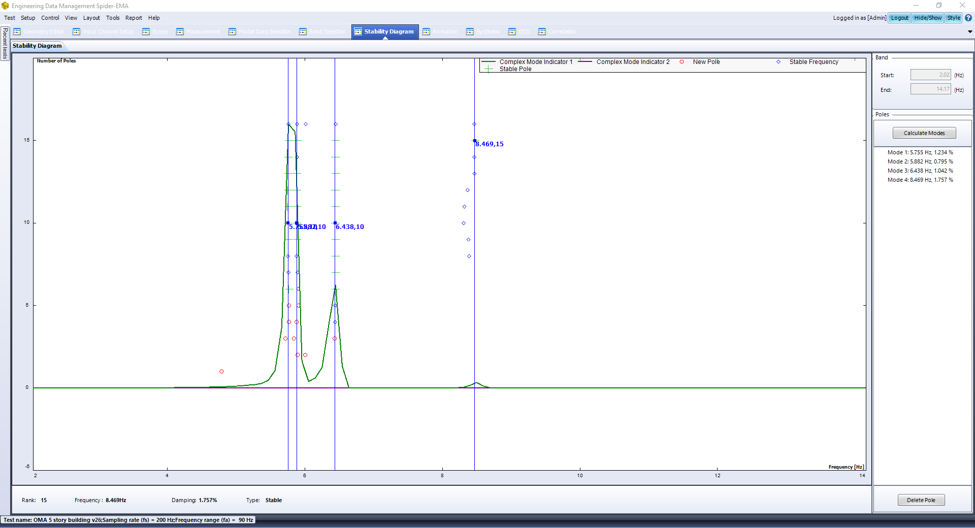Standard Modal Analysis
EDM Modal Standard Modal Analysis provides the user with a complete arsenal of tools, from FRF data selection and parameter identification to results validation and mode shape animation.
Upon completion of the Modal testing, the set of FRF data is made available for the next step: Modal Analysis. You can also add/replace individual FRF signals. The complete set of FRF test signals can be exported, or imported from other sources. These operations are managed by ‘Modal Data Selection’. The FRF signals are organized for a rapid comprehensive review, one by one, or multiply in one graph window.
With one click, the Modal Parameter Identification process can be started. With the help of a Mode Indicator Function (MIF), the natural frequencies can be labeled. The Multivariate, Complex, Real, and Imaginary Sum MIFs are available. MIF indicators aide identifying repeated roots (repeated poles) and closely-space distinct roots.
A Stability Diagram is employed with modal parameter identification. With the Standard Modal Analysis option, the proven Least Square Complex Exponential (LSCE) fitter is implemented for pole identification. The physical poles sought are stable (as opposed to ‘computational poles’ sometimes produced by the LSCE) and can be selected from the Stability Diagram for the next step mode shape calculation, using the Least Square Frequency Domain (LSFD) algorithm.
The resulting mode shape table can be saved and used for mode shape animation. Modal Assurance Criterion (MAC) function and FRF synthesis are also available. These provide means for modal parameter validation.
Features:
Ease of use modal data selection
Signal Smoothing with Deconvolution (for OMA testing only)
MIF: Multivariate MIF, Complex MIF, Real MIF, Imag sum MIF
User selectable frequency band for parameter identification
Stability Diagram
Proven curve fitting method: LSCE
Least square frequency domain (LSFD) algorithm for mode shape calculation
Save/append modes to the shape table
Auto/Cross MAC calculation and display
Import/export modes: UFF format
Animation equation editor for unmeasured DOFs
Mode Shape Animation: wireframe, surface contour, FFD, animation with interpolation
Contour edit, Contour value
Animation smoothing
Node lines
Animation with un-deformed elements
Mode Shape Animation speed control (fast, slow), magnitude control (increase, decrease)
Animation format: Single, Left/Right, Upper/Lower
Modal Shape video saving, graph saving
Synthesized FRF vs. measured FRF, with Correlation and Error values
Advanced Modal Analysis
EDM Modal Advance Modal Analysis includes all the features of Standard Modal Analysis. On top, it provides the Poly-reference modal analysis algorithm to curve fit the FRF matrix from the MIMO FRF testing results. The time domain curve fitting algorithm for the pole identification is Poly reference time domain method (PTD), which is sophisticated and proven.
The selection of the curve fitting method, PTD or LSCE, is automatic based on the type of FRF signal set selected, whether it is single reference or multi reference.
Features:
Includes all features of Standard Modal Analysis, plus,
Poly reference time domain (PTD) curve fitting
Auto selection of curve fitter per single or multiple reference from the FRF data set
Premium Modal Analysis (with Poly-X)
EDM Modal Premium Modal Analysis includes all the features of Standard and Advanced Modal Analysis. On top, it provides Poly-X, which is the poly reference Least Square Complex Frequency domain (p-LSCF) modal analysis algorithm to curve fit the FRF matrix from the MIMO FRF testing results. This frequency domain modal parameter estimator is more efficient and neat on the stability diagram.
The selection of the curve fitting method, Time Domain or Poly-X, is available from the EDM Modal software. It applies to either single reference or poly reference FRF data sets.
Features:
Includes all features of Standard and Advanced Modal Analysis, plus,
Poly-X - Poly reference Least Square Complex Frequency Domain (p-LSCF) curve fitting
Neat Stability Diagram with emphasis on stable poles
Operational Modal Curve Fitter
The modal parameter estimation method, called the Stochastic Subspace Identification (SSI) is added. This dedicated curve fitting method for Operation Modal Analysis is not only cleaner but more efficient as well.
The selection of the curve fitting method, Time Domain, Poly-X, or SSI is available from the EDM Modal software. It applies to either single reference or poly reference cross power spectrum data sets.
Features:
Includes all features of Standard, plus,
Stochastic Subspace Identification (SSI) curve fitting
Neat Stability Diagram with emphasis on stable poles







